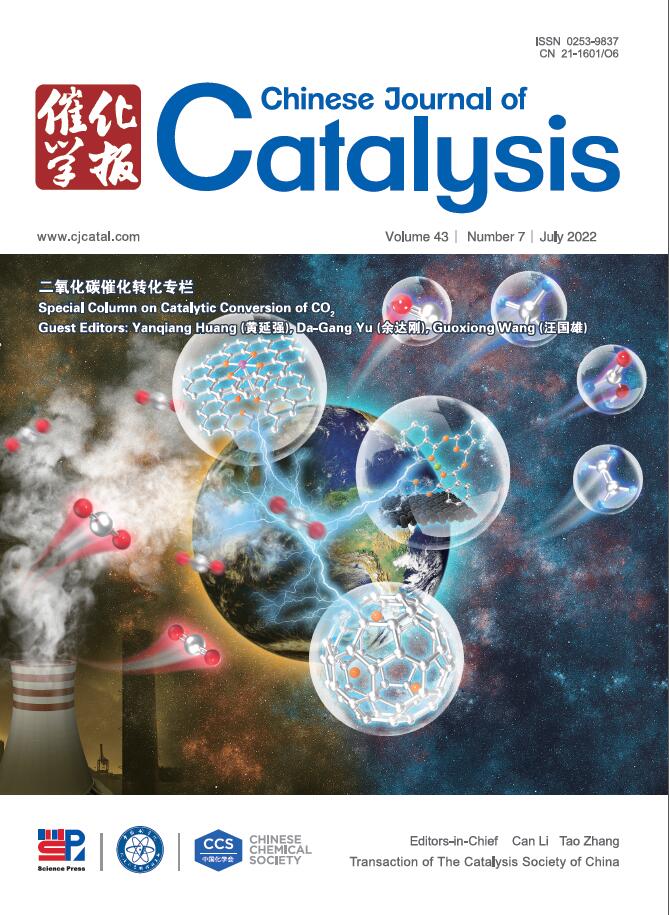利用氧化石墨烯作为桥接剂而无需煅烧高效合成柔性SCR催化剂:催化性能、机理和动力学研究
IF 17.7
1区 化学
Q1 CHEMISTRY, APPLIED
引用次数: 0
摘要
柔性催化剂的机械性能仍然是工业应用的一个重大挑战。在本研究中,氧化石墨烯(GO)既是粘合剂又是氧化还原介质,是金属和有机泡沫之间的重要“桥梁”,从而大大提高了NOx的转化效率。催化活性测试表明,氧化石墨烯改性催化剂的NOx转化率超过95%。氧化石墨烯的加入增强了有机泡沫与金属组分之间的附着力,提高了海绵的表面粗糙度,保证了金属活性位点的均匀稳定分布。此外,氧化石墨烯提高了有效催化物质的含量,提高了选择性催化还原反应中的电子传递效率,降低了扩散阻力。为了阐明NO还原机理,进行了原位漫反射红外傅立叶变换光谱和瞬态反应研究。结果表明,随着反应温度的升高,Eley-Rideal机制和Langmuir-Hinshelwood机制都有助于提高SCR反应速率。本文章由计算机程序翻译,如有差异,请以英文原文为准。
Efficient synthesis of flexible SCR catalysts utilizing graphene oxide as a bridging agent without calcination: Catalytic performance, mechanism and kinetics studies
The mechanical performance of flexible catalysts remains a significant challenge for industrial applications. In this study, graphene oxide (GO) functions as both a binder and a redox mediator, serving as a crucial “bridge” between metal species and the organic foam, thereby substantially enhancing NOx conversion efficiency. Catalytic activity tests demonstrate that the GO-modified [email protected] catalyst achieves a NOx conversion rate exceeding 95%. The incorporation of GO strengthens the adhesion between the organic foam and metal components, increases the surface roughness of the sponge, and ensures the uniform and stable distribution of metal active sites. Additionally, GO enhances the content of effective catalytic species, improves electron transfer efficiency in the selective catalytic reduction reaction, and reduces diffusion resistance. To elucidate the NO reduction mechanism, in situ diffuse reflectance infrared Fourier transform spectroscopy and transient reaction studies were performed. The results indicate that as the reaction temperature increases, both the Eley-Rideal and Langmuir-Hinshelwood mechanisms contribute to promoting the SCR reaction rate.
求助全文
通过发布文献求助,成功后即可免费获取论文全文。
去求助
来源期刊

Chinese Journal of Catalysis
工程技术-工程:化工
CiteScore
25.80
自引率
10.30%
发文量
235
审稿时长
1.2 months
期刊介绍:
The journal covers a broad scope, encompassing new trends in catalysis for applications in energy production, environmental protection, and the preparation of materials, petroleum chemicals, and fine chemicals. It explores the scientific foundation for preparing and activating catalysts of commercial interest, emphasizing representative models.The focus includes spectroscopic methods for structural characterization, especially in situ techniques, as well as new theoretical methods with practical impact in catalysis and catalytic reactions.The journal delves into the relationship between homogeneous and heterogeneous catalysis and includes theoretical studies on the structure and reactivity of catalysts.Additionally, contributions on photocatalysis, biocatalysis, surface science, and catalysis-related chemical kinetics are welcomed.
 求助内容:
求助内容: 应助结果提醒方式:
应助结果提醒方式:


